Although I have never actually said that before, according
to Anton Kozlovic, I probably should have. In his article, The Structural Characteristics of the Cinematic Christ-Figure, Kozlovic argues that Christ-figures in modern film help promote a holy subtext while
subsequently defining 25 characteristics of the cinematic Christ-figure (Kozlovic 2004). Kozlovic’s
argument, on the whole, is not flawed. He cites numerous films that, despite
having a “secular wrapper”, present obvious Christian subthemes. Some of his
examples are particularly strong, such as Superman:
The Movie, where director Richard Donner has admitted to the allusion to Christ, and The Matrix, which
has frequently been both praised and criticized for its overt Christian subtext (Kozlovic 2004). However, although the parallels between
Jesus Christ and the Christ-figures in Kozlovic’s thoroughly analyzed examples
are clear, his analysis and 25 stereotypical characteristics ultimately fail to
highlight what these similarities actually mean!
Action hero? Christ-figure?...Does it matter?
In Christopher Deacy’s critical response to Kozlovic’s
article he addresses the superficial nature of these parallels, asserting the
dishonesty “in using film for no other purpose than to illustrate a particular
religious theme” (Deacy 2006).
Although I feel that this accusation in unnecessarily strong, it does
highlight the challenges of applying Kozlovic’s list in the manner which he
proposes it to be used. Even though elements such as a Judas-like associate and resurrection
can help convey the association with Christ, as is done with Neo in The Matrix, without the appropriate
message, the mere inclusion of these stereotypical characteristics doesn’t
guarantee that a film-maker will be able “engineer powerful Christ-figures into
their production” (Kozlovic 2004).
Furthermore, Kozlovic’s emphasis on superficial characteristics can lead
to misinterpretation by those employing his list to analyze a film from a
theological perspective. As an example, looking at characters from two movies examined last class, Ricky Bobby, from Talladega Nights, has a betrayer associate, his long-time friend and racing partner Cal Naughton Jr., while Stranger than Fiction’s Harold Crick
willingly sacrifices his life. However can either of these characters, played
by Will Ferell (who has blue eyes!), be deemed Christ-figures? Not in my
opinion. More importantly, does it even matter? While being potentially misleading, Kozlovic’s list also seems to imply
that in order to teach the importance of Christ’s message, viewers require a
stereotypical Christ-figure to convey it, something that both Deacy and I feel
is unnecessary. Ultimately, Kozlovic’s checklist appears to help viewers avoid
seeing what they want to by forcing them to see things the way he does...
Blue Eyes!
Will Ferell...Christ Figure?:
Betrayal scene from Talladega Nights: The Ballad of Ricky Bobby:
Scene from Stranger than Fiction when Harold Crick convinces the author narrating his life that she can end it for the sake of the story:
Works Cited:
Kozlovic, Anton. "The Structural Characteristics of the Cinematic Christ Figure." Journal of Religion and Popular Culture. 8. (2004): 1-34.
Deacy, Christopher. "Reflections on the Uncritical Appropriation of Cinematic Christ-Figures: Holy Other or Wholly Inadequate?." Journal of Religion and Popular Culture. 13. (2006): 1-16.



No comments:
Post a Comment